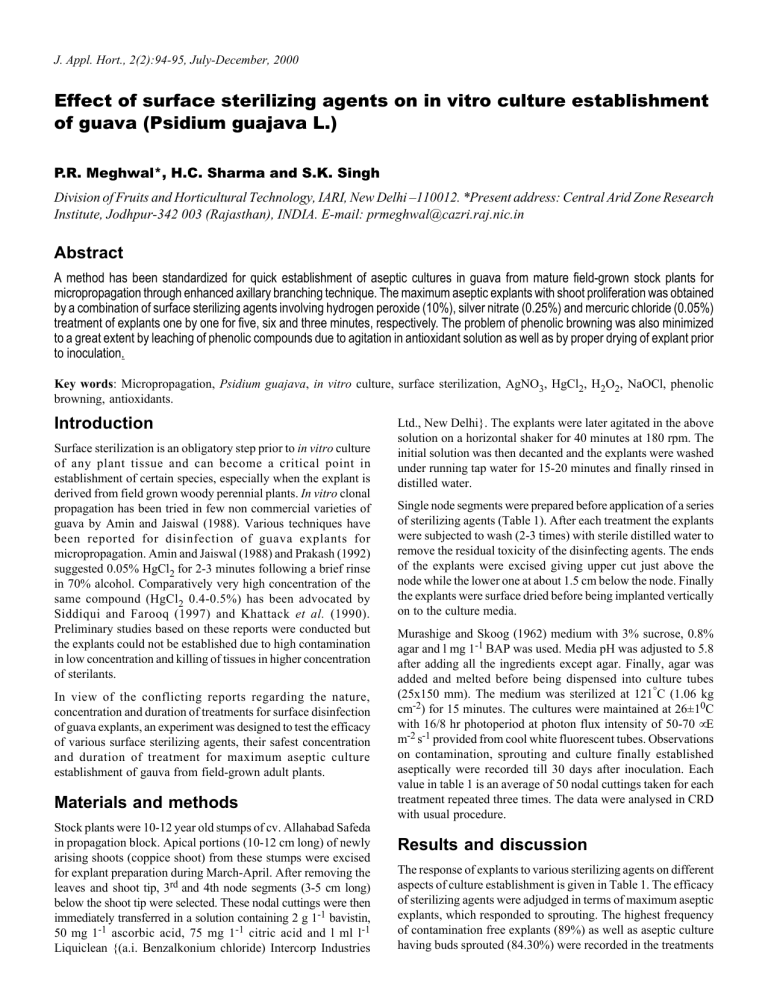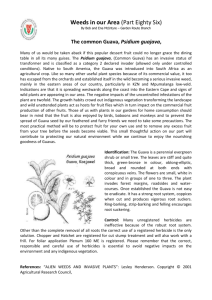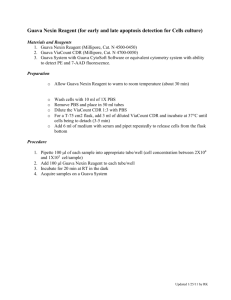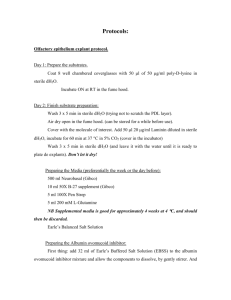Effect of surface sterilizing agents on in vitro culture establishment
advertisement

J. Appl. Hort., 2(2):94-95, July-December, 2000
Effect of surface sterilizing agents on in vitro culture establishment
of guava (Psidium guajava L.)
P.R. Meghwal*, H.C. Sharma and S.K. Singh
Division of Fruits and Horticultural Technology, IARI, New Delhi –110012. *Present address: Central Arid Zone Research
Institute, Jodhpur-342 003 (Rajasthan), INDIA. E-mail: prmeghwal@cazri.raj.nic.in
Abstract
A method has been standardized for quick establishment of aseptic cultures in guava from mature field-grown stock plants for
micropropagation through enhanced axillary branching technique. The maximum aseptic explants with shoot proliferation was obtained
by a combination of surface sterilizing agents involving hydrogen peroxide (10%), silver nitrate (0.25%) and mercuric chloride (0.05%)
treatment of explants one by one for five, six and three minutes, respectively. The problem of phenolic browning was also minimized
to a great extent by leaching of phenolic compounds due to agitation in antioxidant solution as well as by proper drying of explant prior
to inoculation.
Key words: Micropropagation, Psidium guajava, in vitro culture, surface sterilization, AgNO3, HgCl2, H2O2, NaOCl, phenolic
browning, antioxidants.
Introduction
Surface sterilization is an obligatory step prior to in vitro culture
of any plant tissue and can become a critical point in
establishment of certain species, especially when the explant is
derived from field grown woody perennial plants. In vitro clonal
propagation has been tried in few non commercial varieties of
guava by Amin and Jaiswal (1988). Various techniques have
been reported for disinfection of guava explants for
micropropagation. Amin and Jaiswal (1988) and Prakash (1992)
suggested 0.05% HgCl2 for 2-3 minutes following a brief rinse
in 70% alcohol. Comparatively very high concentration of the
same compound (HgCl2 0.4-0.5%) has been advocated by
Siddiqui and Farooq (1997) and Khattack et al. (1990).
Preliminary studies based on these reports were conducted but
the explants could not be established due to high contamination
in low concentration and killing of tissues in higher concentration
of sterilants.
In view of the conflicting reports regarding the nature,
concentration and duration of treatments for surface disinfection
of guava explants, an experiment was designed to test the efficacy
of various surface sterilizing agents, their safest concentration
and duration of treatment for maximum aseptic culture
establishment of gauva from field-grown adult plants.
Materials and methods
Stock plants were 10-12 year old stumps of cv. Allahabad Safeda
in propagation block. Apical portions (10-12 cm long) of newly
arising shoots (coppice shoot) from these stumps were excised
for explant preparation during March-April. After removing the
leaves and shoot tip, 3rd and 4th node segments (3-5 cm long)
below the shoot tip were selected. These nodal cuttings were then
immediately transferred in a solution containing 2 g 1-1 bavistin,
50 mg 1-1 ascorbic acid, 75 mg 1-1 citric acid and l ml l-1
Liquiclean {(a.i. Benzalkonium chloride) Intercorp Industries
Ltd., New Delhi}. The explants were later agitated in the above
solution on a horizontal shaker for 40 minutes at 180 rpm. The
initial solution was then decanted and the explants were washed
under running tap water for 15-20 minutes and finally rinsed in
distilled water.
Single node segments were prepared before application of a series
of sterilizing agents (Table 1). After each treatment the explants
were subjected to wash (2-3 times) with sterile distilled water to
remove the residual toxicity of the disinfecting agents. The ends
of the explants were excised giving upper cut just above the
node while the lower one at about 1.5 cm below the node. Finally
the explants were surface dried before being implanted vertically
on to the culture media.
Murashige and Skoog (1962) medium with 3% sucrose, 0.8%
agar and l mg 1-1 BAP was used. Media pH was adjusted to 5.8
after adding all the ingredients except agar. Finally, agar was
added and melted before being dispensed into culture tubes
(25x150 mm). The medium was sterilized at 121°C (1.06 kg
cm-2) for 15 minutes. The cultures were maintained at 26±10C
with 16/8 hr photoperiod at photon flux intensity of 50-70 µE
m-2 s-1 provided from cool white fluorescent tubes. Observations
on contamination, sprouting and culture finally established
aseptically were recorded till 30 days after inoculation. Each
value in table 1 is an average of 50 nodal cuttings taken for each
treatment repeated three times. The data were analysed in CRD
with usual procedure.
Results and discussion
The response of explants to various sterilizing agents on different
aspects of culture establishment is given in Table 1. The efficacy
of sterilizing agents were adjudged in terms of maximum aseptic
explants, which responded to sprouting. The highest frequency
of contamination free explants (89%) as well as aseptic culture
having buds sprouted (84.30%) were recorded in the treatments
Surface sterilizing agents on in vitro culture establishment of guava (Psidium guajava L.)
95
where H2O2, AgNO3 and HgCl2 were used sequentially. This
might be due to better air space removal by H2O2 and high
sterilizing action of AgN0 3 and HgCl 2 treatments, which
followed later. Amin and Jaiswal (1988) obtained similar results
by giving a rapid rinse in 70% ethyl alcohol to the explants of
guava for air space removal before mercuric chloride treatment
of similar strengths. Comparatively very high concentration of
HgCl2 (0.4%) has been reported by Siddiqui and Farooq (1997)
for guava shoots which contradicts the concentration (0.05%) of
same chemical used in this study as well as those recommended
by Prakash (1992) and Amin and Jaiswal (1987). Such a high
level of HgCl2 may be lethal to the guava explants as it is very
sensitive. Khattack et al. (1990) tried 0.5% HgCl2 as one of the
concentration in several treatments and they found 80% infection
free explants but the treatment caused excessive browning and
ultimately none of the explants could sprout.
Table 1. Effect of surface sterilizing agents on in vitro culture
establishment of guava cv. Allahabad Safeda in MS medium
containing 1 mg l-1 BAP (after 30 days)
Treatment Contamination Per cent
Final Aseptic
free explant
sprouting cultures established
(%)
(%)
T1
T2
T3
T4
T5
T6
T7
T8
T9
CD ( p=0.01)
21.6(27.77)*
0.0
1.66(4.30)
41.66(40.16)
13.33(21.33)
89.00(71.36)
55.00(47.88)
63.33(52.78)
64.00(53.17)
9.36
80.00(63.55)
98.33(85.69)
70.00(56.84)
80.00(63.55)
55.00(45.96)
86.66(69.24)
90.00(71.95)
61.66(49.81)
86.66(69.24)
10.80
8.33(16.59)
0.0
0.0
35.00(36.24)
0.0
84.30(63.93)
48.33(44.04)
56.00(48.44)
61.66(51.81)
9.91
T1 = Mercuric chloride (0.05%) (3 minutes); T2 = Hydrogen per oxide
(10%, v/v) for 10 minutes; T 3 = NaOCI (10%, v/v) 5 minutes;
T4 = 70% ethanol (30 seconds followed by HgCl2 (0.05%) for 3 minutes;
T5 = 70% ethanol followed by NaOCI (10%) for 5 minutes; T6 = H202
(10%, v/v ) for 5 minutes followed by AgN03 (0.25%) for 5 minutes
followed by HgCl2 (0.05%) of 3 minutes; T7 = H202 (10%, v/v ) for 5
minutes followed by HgCl2 (0.05%) of 3 minutes; T8 = AgN03 (0.25%)
for 5 minutes followed by HgCl 2 (0.05%) of 3 minutes;
T9 = 70% ethanol followed by AgN03 (0.25%) for 5 minutes followed by
HgCl2 (0.05%) of 3 minutes
All the cultures were contaminated in the treatments where
NaOCI was used either alone or with ethyl alcohol (T5 and T6
Table 1). These treatment also caused comparatively higher
browning. H2 O2 alone also failed to establish any culture,
however bud sprouting was highest (98%) initially but got
infected in further course of time. Higher sprouting may be due
to lesser injury to the buds by H2O2, which is a milder sterilant
and higher contamination may be attributed to insufficient
sterilization by H2O2 alone.
In general, culture establishment of guava from mature field
grown plant is often hampered by an another problem i.e.
phenolic browning. Amin and Jaiswal (1987) and Prakash (1992)
had also reported such problem for which they employed various
techiniques to overcome explant browning. However, the culture
Fig. 1. Axillary bud sprouting in guava without phenolic
browning (after 15 days)
establishment in this study were not much effected by browning
phenomenon (Fig. 1). This might be due to explant collection
from partially rejuvenated shoots during active growth phase
(March-April). Collection of explants during active growth
flushes or from juvenile plant material has been suggested by
Bon et al. (1988). In case of guava also, Amin and Jaiswal (1988)
found minimum degree of media browning during April to June
period. Agitation of explants in antioxidant solution might have
allowed maximum leaching of phenolic substances as well as
reduction in the enzymatic activity by reducing agents. Such
reduction in enzymatic activity due to aqueous soak in the
antioxidant solution has earlier been reported by Ziv and Havely
(1983) in the explants of Strelitzia reginae. The lower degree of
phenolic browning observed here may also be due to proper
surface drying of explants (including cut ends) prior to
inoculation. Similar results have been obtained by Fitchet (1989)
in guava who attributed surface drying of explants as fully
responsible for control of browning due to phenolic substances.
References
Amin, M.N. and V.S. Jaiswal, 1987. Rapid clonal propagation of guava
through in vitro shoot proliferation on nodal explants of mature
trees. Plant Cell Tissue Organ Cult., 9: 235-243.
Amin, M.N. and V.S. Jaiswal, 1988. Micropropagation as an aid to
rapid cloning of a guava cultivar. Scientia Hort., 36: 89-95.
Bon, M.S., M. Gendr and A. Frauchet, 1988. Vegetative propagation
of radiata pine by tissue culture. Scientia Hort., 34: 283-291.
Fitchet, N. 1989. Tissue culture of guava. Information Bulletin, Citrus
and Sub tropical fruit Res. Inst. No. 202, 1-2.
Khattack, M.S., M.N. Malik and M.A. Khan, 1990. Effect of surface
sterilization agents on in vitro cultures of guava cv. Safeda tissue.
Sarhad J. Agric., 6: 151-154.
Murashige, T. and F. Skoog, 1962. A revised medium for rapid growth
and bioassay with tobacco tissue culture. Physiol. Plant., 15: 475497.
Prakash, H. 1992. Micropropagation of guava. A thesis submitted to
G.B. Pant Uni. of Agri & Technology, Pantnagar.
Siddiqui, Z.M. and S.A. Farooq, 1997. Tissue culture studies on the
nodal explants of guava. Indian J. Hort., 54(4): 296-297.
Ziv, M. and A.H. Havely, 1983. Control of oxidative browning and in
vitro propagation of Strelitzia reginae. HortScience, 18:434-436.



